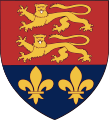
The Channel Islands are an archipelago in the English Channel, off the French coast of Normandy. They are divided into two Crown Dependencies: the Bailiwick of Jersey, which is the largest of the islands; and the Bailiwick of Guernsey, consisting of Guernsey, Alderney, Sark, Herm and some smaller islands. Historically, they are the remnants of the Duchy of Normandy. Although they are not part of the United Kingdom, the UK is responsible for the defence and international relations of the islands as it is for the other Crown Dependency, the Isle of Man, and the British Overseas Territories. The Crown Dependencies are neither members of the Commonwealth of Nations, nor part of the European Union. They have a total population of about 171,916, and the bailiwicks' capitals, Saint Helier and Saint Peter Port, have populations of 33,500 and 18,207 respectively.

Normandy is a geographical and cultural region in northwestern Europe, roughly coextensive with the historical Duchy of Normandy.
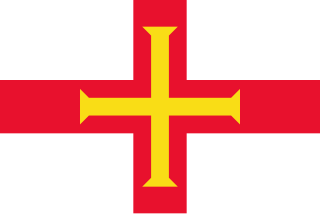
The flag of Guernsey was adopted in 1985 and consists of the red Saint George's Cross with an additional gold Norman cross within it. The creation was prompted by confusion at international sporting events over competitors from Guernsey and England using the same flag. It was designed by the Guernsey Flag Investigation Committee led by Deputy Bailiff Sir Graham Dorey. The flag was first unveiled on the island on 15 February 1985. The gold cross represents William the Bastard, Duke of Normandy. William purportedly was given such a cross by Pope Alexander II and flew it on his standard in the Battle of Hastings. Since 2000, a red ensign with the cross in the fly has been used as the government's civil ensign and as a blue ensign.

The coat of arms of Prince Edward Island, officially the King's Arms in Right of Prince Edward Island, are the coat of arms of Prince Edward Island, being the arms of King Charles III in right of the province. They were created when the shield and motto in the achievement were granted in 1905 by royal warrant from King Edward VII. The latest iteration was given by the Canadian Heraldic Authority in 2002.

The coat of arms of Saskatchewan, officially known as His Majesty's Arms in right of Saskatchewan, is the heraldic symbol representing the Canadian province of Saskatchewan.

A saltire, also called Saint Andrew's Cross or the crux decussata, is a heraldic symbol in the form of a diagonal cross. The word comes from the Middle French sautoir, Medieval Latin saltatoria ("stirrup").

The coat of arms of the province of Quebec was adopted by order-in-council of the Government of Quebec on 9 December 1939, replacing the arms assigned by royal warrant of Queen Victoria on 26 May 1868.

The coat of arms of England is the coat of arms historically used as arms of dominion by the monarchs of the Kingdom of England, and now used to symbolise England generally, but not officially. The arms were adopted c.1200 by the Plantagenet kings and continued to be used by successive English and British monarchs; they are currently quartered with the arms of Scotland and Ireland in the coat of arms of the United Kingdom. Historically they were also quartered with the arms of France, representing the English claim to the French throne, and Hanover.

The Bailiwick of Guernsey is a self-governing British Crown Dependency off the coast of Normandy, France, comprising several of the Channel Islands. It has a total land area of 78 square kilometres (30 sq mi) and an estimated total population of 67,334.

The flag of Jersey is composed of a red saltire on a white field. In the upper quadrant the badge of Jersey surmounted by a yellow "Plantagenet crown". The flag was adopted by the States of Jersey on 12 June 1979, proclaimed by Queen Elizabeth II on 10 December 1980 and first officially hoisted on 7 April 1981.
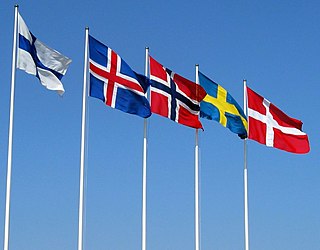
A Nordic cross flag is a flag bearing the design of the Nordic or Scandinavian cross, a cross symbol in a rectangular field, with the centre of the cross shifted towards the hoist.

The coat of arms of Denmark has a lesser and a greater version.

The coat of arms of Jersey is the heraldic device consisting of a shield charged with three gold lions on a red field. Utilised unofficially before the 20th century, its status as the coat of arms of the Bailiwick of Jersey was formalized in 1907. The escutcheon is featured on the flag of the dependency.

The lion is a common charge in heraldry. It traditionally symbolises courage, nobility, royalty, strength, stateliness and valour, because historically the lion has been regarded as the "king of beasts". The lion also carries Judeo-Christian symbolism. The Lion of Judah stands in the coat of arms of Jerusalem. Similar-looking lions can be found elsewhere, such as in the coat of arms of the Swedish royal House of Bjelbo, from there in turn derived into the coat of arms of Finland, formerly belonging to Sweden.
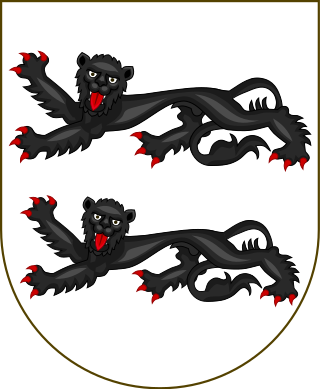
The leopard in heraldry is traditionally depicted the same as a lion, but in a walking position with its head turned to full face, thus it is also known as a lion passant guardant in some texts, though leopards more naturally depicted make some appearances in modern heraldry. The Oxford Guide to Heraldry makes little mention of leopards but glosses leopard as a "term used in medieval heraldry for lion passant guardant. Now used for the natural beast." Another name for this beast is the ounce.

The coat of arms of Guernsey is the official symbol of the Channel Island of Guernsey. It is very similar to the arms of Normandy, Jersey, and England.

The flag of Sark is white with a red St. George's cross and a red canton containing the two yellow lions from the flag of Normandy. The flag was formally granted as the Flag of Sark in 2020.
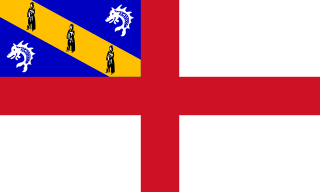
The flag of Herm is white with a red St George's Cross with a banner of the arms of Herm in the canton; the arms are azure, between two dolphins argent a bend or bearing three cowled Benedictine monks sable. The ratio of the flag is 3:5. It was designed by the British vexillologist William Crampton. The arms of Herm was adopted in 1953. Around 1951 the island used a blue flag with the coat of arms of Guernsey near the hoist.

Jessant-de-lys is a heraldic term denoting a fleur-de-lys issuing out of any object. It is most frequently seen in conjunction with a leopard's face, meaning in heraldic language the face of a lion.

The coat of arms of the Angevin dynasty varied over time, but always included a lion.












